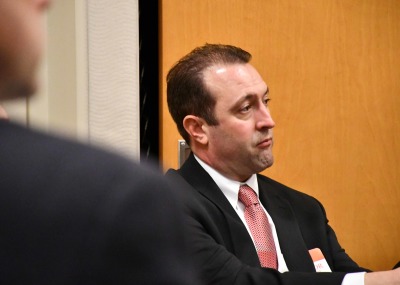Sweeping budget cuts have cast a shadow over the legislative session this year, downsizing and delaying ambitious policies coming out of Sacramento. Agricultural lobbyists will be hitting that message hard with lawmakers looking to make their policy mark.
Gov. Gavin Newsom’s proposal for reining in a record shortfall taps into a range of options, from pulling back unspent dollars to delaying funding and reshuffling money across programs. He released a plan last week that estimates a $291.5 billion budget and a $38 billion deficit, which is a far more optimistic scenario than the $68 billion estimate from the Legislative Analyst’s Office. While the number will remain murky until the April tax deadline, the spending gap is certain to be massive, meaning farmers will see significant drops in incentive grant dollars over multiple years.
“This is a story of correction, a story of normalization,” said Newsom, referring to the two years of budget surpluses that preceded the deficit, when unveiling the initial budget proposal to reporters.
Republicans countered that the wild fiscal swings led to reckless spending under one-party rule and that their calls for fiscal responsibility fell on deaf ears.
“Welcome to year six of Gavinomics, where his budgets turn surpluses into deficits and his policies push Californians to flee,” said Senate Minority Leader Brian Jones of San Diego.
The California Chamber of Commerce, which often backs agricultural interests on issues in the Capitol, sought to thread the needle in its remarks.
“The governor has correctly focused on those things that will help California’s economy succeed,” said CalChamber President and CEO Jennifer Barrera, who saluted investments in infrastructure, small businesses and workforce development as well as Newsom’s reluctance to raise taxes.
Agricultural organizations are just beginning to dig into the many provisions outlined in the sweeping proposal, and the budget conversations, negotiations and details will continue to evolve throughout the legislative session, though the overall approach will likely remain the same.
 California Farm Bureau's Chris Reardon
California Farm Bureau's Chris ReardonNewsom plans to draw $13 billion from the state’s rainy-day reserves, rescind $8.5 billion in existing allocations and delay more than $5 billion in funding through 2028, long after the governor has termed out of office. He shot down the idea of a wealth tax or raising other taxes to build revenue.
The proposal includes the second half of a $6 billion cut to a $54 billion climate package passed in 2022, while delaying another $1.9 billion in climate spending and shifting $1.8 billion to the Greenhouse Gas Reduction Fund (GGRF), which houses cap-and-trade revenues. About $10 billion in federal climate funding would offset some of those spending cuts, according to the governor’s office.
Newsom is working with lawmakers to place a bond proposal on the November ballot to backfill many of the spending gaps, likely with some money for climate-smart agriculture.
“We believe our climate bond legislation becomes all the more important as a potential funding mechanism in the face of the current economic landscape,” said Assemblymember Eduardo Garcia of Coachella, who authored one of five bond proposals circulating in the Legislature last year.
The Association of California Water Agencies has pledged to advocate for incorporating in the bond investments for groundwater recharge, water storage and repairing conveyance canals, among other water projects.
The plan maintains nearly $1 billion in investments from previous budget surpluses for various programs relating to sustainable agriculture, while carving out about $100 million in reductions. It would shift $24 million for livestock methane reduction from the state’s general fund to the GGRF and delay it a year, and it would pull back $23 million for enteric methane research, leaving $2 million.
“California is the place on this globe that is making these kinds of substantial investments in livestock methane reduction programs,” CDFA Secretary Karen Ross told stakeholders during a separate press conference.
Dairy Cares Executive Director Michael Boccadoro shared with Agri-Pulse the industry’s gratitude with the ongoing commitment to cut emissions of the short-lived climate pollutant. The funding would provide CDFA with enough resources to continue implementing programs for digesters and alternative manure management practices, complementing $85 million in USDA funding for manure projects, he explained.
“These programs are among the state’s most cost-effective and productive climate projects and are critical to achieving the state’s methane reduction and overall climate goals,” he said in an email. “Dairy methane reduction efforts are accounting for over 25% of all reductions from the state’s climate investments.”
Boccadoro plans to work with the administration and the Legislature to find funding for the enteric program “as soon as possible” to incentivize early adopters of the feed additives. That money could come from the GGRF as well.
While dairy farmers race toward a rigid methane goal, California’s ports likewise have aggressive climate mandates to meet. Newsom’s plan would cut $24 million for converting drayage trucks to ZEVs. The Port of Oakland, which ships most of the state’s agricultural products, would lose $96 million set aside for improvements. The budget would also delay $100 million for port and freight infrastructure.
The overall drop of incentive funds for air quality was disappointing but not surprising for agricultural interests. Matthew Allen, vice president of state government affairs at the Western Growers Association, told Agri-Pulse that it is “hugely important” to safeguard previous funding for upgrading tractors and other farm equipment as well as for rebates on clean vehicle purchases.
“It's something we've been very, very successful on across our industry, in working with our growers on transitioning that equipment,” said Allen.
He has been hearing “a great deal” more from his farmers about rural grid constraints now that agencies have adopted the administration’s energy goals into state code and have begun implementing some of the regulations.
It’s easy to be “in the know” about agriculture news from coast to coast! Sign up for a FREE month of Agri-Pulse news. Simply click here.
Roger Isom, president and CEO of the Western Agricultural Processors Association hoped a drop in public investment would lead agencies to rebalance their climate expectations.
“If the shortfall is the reasoning behind the reduction in funding, then we would expect to see some flexibility in the very ambitious timeframes and goals the state has set for air quality, especially the climate change goals,” he said in a statement to Agri-Pulse.
 Matthew Allen, Western Growers
Matthew Allen, Western GrowersShannon Douglass, the newly elected president of the California Farm Bureau, echoed the sentiment.
“[California’s farmers and ranchers] have persevered in the face of often onerous regulations to produce America’s most bountiful food supply, while managing farm and family budgets amid difficult times,” she said in a press release. “And just as our farm families must balance their budgets, we hope our political leaders recognize that it is time for California to get its fiscal house in order as well.”
Also within the realm of climate emissions, the budget plan would cut nearly $19 million from the Food Production Investment Program, leaving the California Energy Commission with $46 million in previous allocations. The Agricultural Council of California helped to revive the energy efficiency program recently after lagging financial support left it in limbo for several years.
Smaller CDFA incentives programs are on the chopping block as well. The new Farm to Community Food Hubs Program would lose $14 million, maintaining just $600,000 to keep it afloat this year. Grants would drop by $8.5 million for supplying gas station refrigerators that stock healthy options in food deserts, though the program has already received $12 million.
“It didn't wipe out these funds, which is a good thing,” Chris Reardon, who directs government affairs at the California Farm Bureau, told Agri-Pulse in an interview. “Once you wipe them out, it's hard to get them back.”
Farmers also face indirect impacts to water funding. The administration would make about $800 million in cuts and delays to various programs over a three-year span, while adding new funding for flood protection. It would shift to the GGRF about $20 million in grants for a program upgrading irrigation pumps and other equipment, known as SWEEP. It would cut $13 million from a $75 million grant program helping agricultural businesses recover from drought and floods. And it would rescind $6 million for technical assistance that helps farmers navigate and implement the many incentive-based water conservation practices.
While some aspects of state government are shrinking, others are growing. The administration is dedicating $6 million—with $7 million in ongoing funding—to boosting resources for the State Water Resources Control Board to take on more federal duties in light of the Sackett v. EPA decision limiting the reach of the Clean Water Act. The board would increase waste discharge fees to account for the costs.
While many eyes have been on the budget, environmental groups have raised a red flag over what was left out of the proposal. Last year Newsom signed into law Senate Bill 253, a controversial measure requiring large companies to report their climate emissions throughout the supply chain. The Air Resources Board pegged the implementation cost at $11 million. While the proposal does not detail any funding for the bill, CalEPA Secretary Yana Garcia assured reporters that it “remains a live conversation with the Legislature,” while a Finance Department official noted that the lack of funding “isn’t a reflection of this particular bill” and that the conversations over such recently enacted legislation will continue through this spring.
With a better understanding of tax revenues, the administration’s update to the budget proposal, known as the May revise, will provide a more definitive roadmap for state spending. Reardon, however, fears Newsom’s initial proposal is likely the best scenario to expect for the incentives programs.
“If we go down the road in the May revise and this gets worse, substantially worse, do we start seeing programs go away?” he asked.
For more news, go to Agri-Pulse.com.


